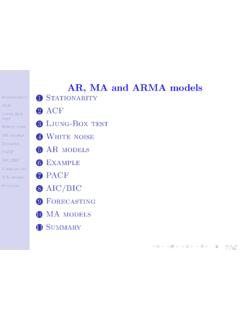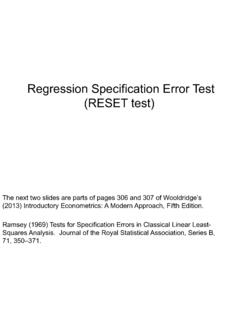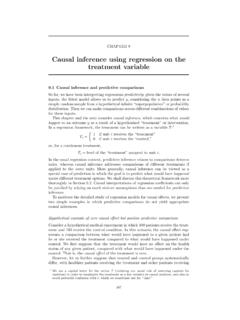Transcription of Omitted Variable Bias: The Simple Case - Hedibert
1 Omitted Variable Bias: The Simple Case1 / 8 IngredientesSuppose that we omit a Variable that actually belongs in thetrue (or population) is often called the problem of excluding a relevantvariable or under-specifying the problem generally causes the OLS estimators to the bias caused by omitting an important variableis an example of misspecification / 8 Let us begin assuming that the true population model isy= 0+ 1x1+ 2x2+uand that this model satisfies Assumptions interest: 1, the partial effect :yis log of hourly wage,x1is education, andx2is a measure of innate ability. To get an unbiased estimatorof 1, we should run a regression ofyonx1andx2(whichgives unbiased estimators of 0, 1and 2).However, due to our ignorance or data unavailability, weestimate the model by / 8In other words, we perform a Simple regression ofyonx1only, obtaining the equation y= 0+ 1x1We use the symbol rather than to emphasize that 1comes from an underspecified / 8We can derive the algebraic relationship 1= 1+ 2 where 1and 2are the slope estimators (if we could havethem) from the multiple regressionyionxi1,xi2i= 1.
2 ,n,and is the slope from the Simple regressionxi2onxi1i= 1,.., depends only on the independent variables in thesample, we treat it as fixed (nonrandom) when computingE( ).5 / 8 bias sizeIt is known that 1and 2are unbiased for 1and ,E( 1) =E( 1+ 2 )=E( 1) +E( 2) = 1+ 2 which implies that the bias in 1isBias( 1) =E( 1) 1= 2 .Because the bias in this case arises from omitting theexplanatory variablex2, the term on the right-hand side ofthe above equation ( 2 ) is often called the Omitted / 8It is easy to see that bias ( 1) = 0 when1 2= 0 The Omitted variablex2is not in the true = 0 Recall that is the slope from the Simple regressionxi2onxi1i= 1,..,n,which is directly related to the correlation betweenx1andx2.
3 Therefore, whenx1andx2are uncorrelated,omittingx2does NOT lead to biased estimate of 1,regardless of the value of (x1,x2)>0 Corr(x1,x2)<0 2>0 Positive biasNegative bias 2<0 Negative biasPositive bias7 / 8 Wage exampleMore ability higher productivity higher wages 2>0 inwage = 0+ 1educ + 2abil +u,Conjecture: educ and abil are positively correlatedOn average, individuals with more innate ability choosehigher levels of : OLS estimates fromwage = 0+ 1educ +u,areon averagetoo / 8









